Industry-first System to Safely Generate Blended Hydrogen/Nitrogen Gas
Taking orders for the YMHN-50 Hydrogen Trace Gas Generator
Yamaha Fine Technologies Co., Ltd., a subsidiary of Yamaha Corporation, will begin taking orders for the YMHN-50 on March 2. The YMHN-50 is a system for automatic generation of the non-flammable hydrogen-nitrogen gas blend that is used as trace gas* for leak testing of airtight products.
![[ Image ] YMHN-50](images/2002210101.jpg)
The YMHN-50 can generate a hydrogen-nitrogen gas blend (below, “hydrogen trace gas”) from just an injection of purified water, and is also capable of generating hydrogen trace gas easily and economically.
- * Trace gas: Very small quantities of a gas that, in product airtightness investigations and testing, is mainly used to detect leakage in test subjects.
Summary
- Generates hydrogen from purified water and extracts nitrogen from air, then blends them precisely to produce hydrogen trace gas.
- Highly reliable safety system emits no flammable hydrogen gas.
- Under Japanese law, no legal applications need be submitted for installation, and the system can be installed smoothly into a production line.
| Product name | Model number | Order acceptance start date |
|---|---|---|
| Hydrogen trace gas generator | YMHN-50 | March 2 (Monday) |
Scheduled number of sales in the first year (domestic, overseas): 5 units in total
Development background
Although gas-type leak testing generally uses helium gas, the price of helium gas continues to rise as a result of supply shortages. Accordingly, a new inspection method that uses hydrogen trace gas has been attracting attention in recent years.
However, using hydrogen trace gas for inspections requires the purchase of expensive gas cylinders, so the high level of running costs was an issue. Up until now, there has been no device that could generate hydrogen trace gas equipped with safety measures that would allow it to be built into a leak testing line.
This situation led us to apply a range of safety measures, including adopting the risk assessment and analysis methods employed in process plants, and building appropriate control safety (device redundancy, etc.) in line with the ISO13849-1 safety standard, and ultimately succeeding in the creation of the first system in the industry to safely generate hydrogen trace gas*.
- *As of February 2020, according to investigations by Yamaha Fine Technologies
Main features
1. Low running costs
The YMHN-50 generates hydrogen trace gas from purified water and air, so running costs are far lower than buying and using gas cylinders. For example, if 50 NL/min of gas is used on a 24/365 basis, the initial equipment investment can be recouped in around one year compared to the use of hydrogen-nitrogen mixed gas cylinders, and in around 4.5 years compared to helium gas.
(Calculated by Yamaha Fine Technologies using gas prices current in February 2020)
2. High safety level
Conventional hydrogen-nitrogen mixing systems do not monitor the concentration of the generated gas, so there was the risk that an equipment fault could cause continuous generation of a flammable gas mixture. The YMHN-50 utilizes doubly redundant densitometers to monitor hydrogen concentration in the generated gas mixture. Even if a fault causes the generation of a flammable gas mixture, the system immediately halts the output of blended gas. Also, when output is stopped, power supply is cut off from the hydrogen generator that produces the 100% hydrogen that is the hazard source. Any 100% hydrogen remaining inside the hydrogen generator is blended with nitrogen as it is vented (patent pending) to further enhance safety.
3. Easy operation
Only purified water needs to be replenished to generate hydrogen trace gas, which eliminates the everyday task of replacing gas cylinders, a significant burden on workers. Operation is simple, using a streamlined GUI on a large color touch panel. No tiresome setup is required, so the only operations workers must perform on a daily basis are pressing the start and stop buttons.
What is gas-type leak testing?
This is a quality control test performed on products that are required to be airtight. Trace gas is injected into the product and detectors outside it perform a quantitative test. The two test methods are the chamber type and the sniffer type, which are selected to suit the specific application. Leak testing has high reliability and performance, so it is used for products for which safety assurance is particularly critical, such as food containers, aluminum wheels, fuel tanks, and oil drums.
The newly developed YMHN-50 works with our YHLD-100 Hydrogen Leak Detector or YLD-510 Mass Spectrometry Leak Detector, to build a leak testing system that enables automated testing in production lines.
Example of using the YHLD-100 in a sniffer-type system
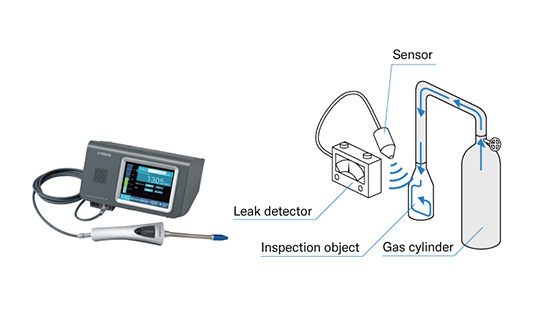
Example of using the YLD-510 in a chamber-type system
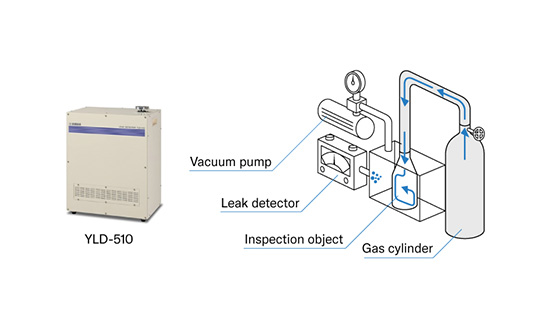
Example of a leak testing system for resin containers
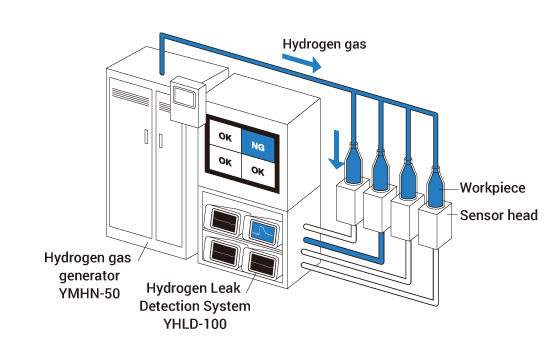
Product specifications
| Product name | Hydrogen trace gas generator |
|---|---|
| Model number | YMHN-50 |
| Generatable hydrogen concentration | Max. 3.5 vol% |
| Trace gas output flow rate | Max. 50 NL/min |
| Trace gas output pressure | Max. 390 kPa |
| Supplied water | Purified water (electrical conductivity of 0.2 µ S/cm or below) |
| External dimensions | W1,200 mm x H1,770 mm x D1,310 mm |
| Installation environment | Temperature 5 to 35℃ , humidity below 85%, without condensation |
| Weight | Approx. 600 kg |
External diagrams
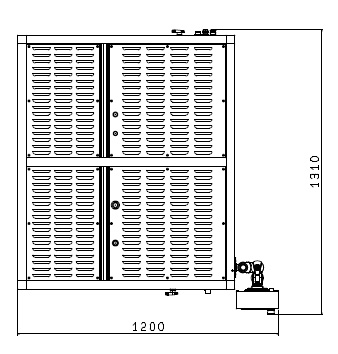
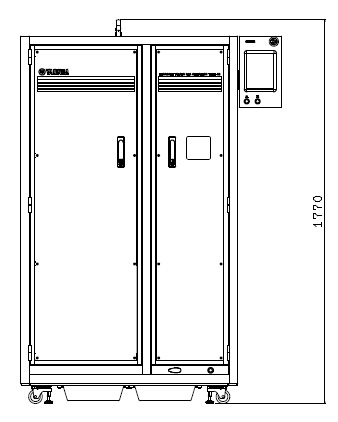
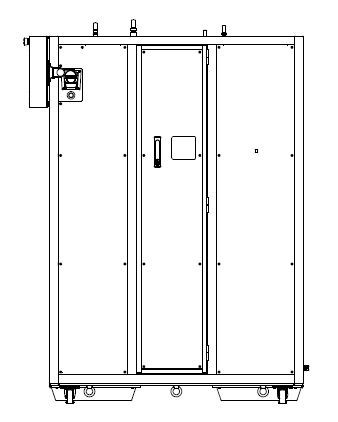
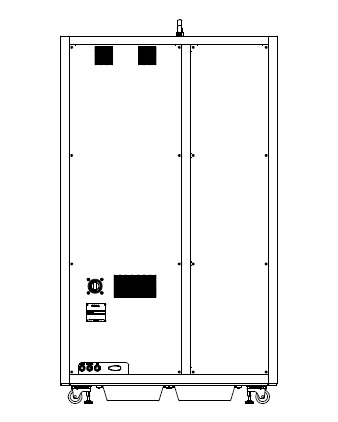
For details of product specifications, refer to the product website.
https://www.yamahafinetech.co.jp/en/fa_products/h_leakdetector/ymhn_50/
